Optimal Legislative County Clustering in North Carolina
IF 1.5
Q2 SOCIAL SCIENCES, MATHEMATICAL METHODS
引用次数: 8
Abstract
Abstract North Carolina’s constitution requires that state legislative districts should not split counties. However, counties must be split to comply with the “one person, one vote” mandate of the U.S. Supreme Court. Given that counties must be split, the North Carolina legislature and the courts have provided guidelines that seek to reduce counties split across districts while also complying with the “one person, one vote” criterion. Under these guidelines, the counties are separated into clusters; each cluster contains a specified number of districts and that are drawn independent from other clusters. The primary goal of this work is to develop, present, and publicly release an algorithm to optimally cluster counties according to the guidelines set by the court in 2015. We use this tool to investigate the optimality and uniqueness of the enacted clusters under the 2017 redistricting process. We verify that the enacted clusters are optimal, but find other optimal choices. We emphasize that the tool we provide lists all possible optimal county clusterings. We also explore the stability of clustering under changing statewide populations and project what the county clusters may look like in the next redistricting cycle beginning in 2020/2021. Supplementary materials for this article are available online.北卡罗来纳州最优立法县集聚
摘要北卡罗来纳州的宪法要求州立法区不应分割县。然而,为了遵守美国最高法院的“一人一票”规定,必须对各县进行拆分。鉴于各县必须划分,北卡罗来纳州立法机构和法院提供了指导方针,旨在减少各县在不同地区的划分,同时遵守“一人一票”的标准。根据这些指导方针,各县被划分为集群;每个集群包含指定数量的区域,这些区域是独立于其他集群绘制的。这项工作的主要目标是根据法院在2015年制定的指导方针,开发、提出并公开发布一种算法,以优化各县的集群。我们使用该工具来研究2017年重新划分选区过程中颁布的集群的最优性和唯一性。我们验证了制定的集群是最优的,但找到了其他最优选择。我们强调,我们提供的工具列出了所有可能的最佳县集群。我们还探讨了在全州人口变化的情况下集群的稳定性,并预测了2020/2021年开始的下一个重新划分周期中,县集群可能会是什么样子。本文的补充材料可在线获取。
本文章由计算机程序翻译,如有差异,请以英文原文为准。
求助全文
约1分钟内获得全文
求助全文
来源期刊

Statistics and Public Policy
SOCIAL SCIENCES, MATHEMATICAL METHODS-
CiteScore
3.20
自引率
6.20%
发文量
13
审稿时长
32 weeks
 求助内容:
求助内容: 应助结果提醒方式:
应助结果提醒方式:


